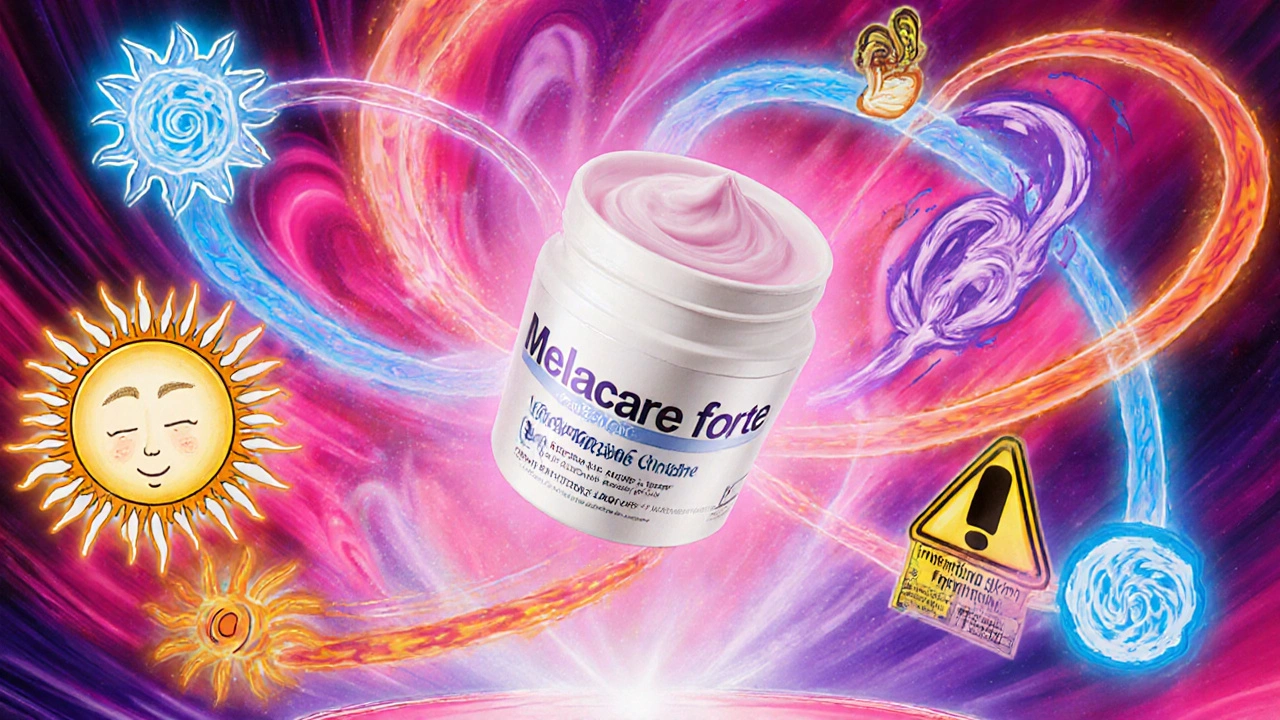Melacare Forte Cream is a prescription-strength topical treatment used to treat stubborn skin discoloration like melasma, post-inflammatory hyperpigmentation, and dark spots. It combines three powerful ingredients: hydroquinone (4%), mometasone (0.1%), and tretinoin (0.025%). This triple-action formula works fast-but it’s not the only option. Many people wonder if there are safer, gentler, or more accessible alternatives. Here’s what actually works, what doesn’t, and which option fits your skin type and goals.
How Melacare Forte Works
Melacare Forte isn’t just a cream-it’s a targeted medical intervention. Each ingredient has a specific job:
- Hydroquinone blocks melanin production in skin cells, fading dark spots over time.
- Mometasone is a corticosteroid that reduces redness, swelling, and irritation-often caused by other acne or pigmentation treatments.
- Tretinoin speeds up skin cell turnover, helping shed pigmented cells faster and letting newer, brighter skin rise to the surface.
Together, they can show visible results in 4-8 weeks for many users. But this combo isn’t gentle. Hydroquinone can cause skin irritation, especially in darker skin tones. Long-term use (over 3-6 months) carries a risk of ochronosis-a rare but permanent blue-black discoloration. Mometasone can thin the skin if used too long, and tretinoin makes skin more sensitive to sunlight.
Why People Look for Alternatives
People stop using Melacare Forte for several real reasons:
- They developed redness, peeling, or burning that didn’t go away.
- They’re pregnant or breastfeeding and were told to avoid hydroquinone.
- They’re worried about steroid side effects from mometasone.
- They can’t get a prescription easily or afford the cost.
- They want something they can buy over the counter without seeing a doctor.
These aren’t just complaints-they’re valid concerns backed by dermatology guidelines from the American Academy of Dermatology and the British Association of Dermatologists.
Alternative #1: Kojic Acid + Niacinamide Creams
If you want to avoid hydroquinone entirely, kojic acid and niacinamide are two of the best science-backed replacements.
Kojic acid comes from fermented rice and stops melanin production without the risks of hydroquinone. Studies show it’s about 60-70% as effective as hydroquinone for melasma, but with far fewer side effects.
Niacinamide (vitamin B3) reduces pigment transfer between cells. It also strengthens the skin barrier and calms inflammation. A 2023 study in the Journal of Clinical and Aesthetic Dermatology found that a 4% niacinamide cream improved melasma by 38% after 12 weeks-similar to low-dose hydroquinone.
Look for products like The Ordinary Niacinamide 10% + Zinc 1% or Dr. Sheth’s Kojic Acid + Niacinamide Serum. These are affordable, available without a prescription, and safe for daily use. They won’t work as fast as Melacare Forte, but they’re much kinder to the skin and can be used long-term.
Alternative #2: Azelaic Acid (15-20%)
Azelaic acid is a favorite among dermatologists for sensitive skin and darker skin tones. It works by inhibiting abnormal melanocytes-those overactive pigment cells-without affecting healthy skin.
It’s FDA-approved for melasma and rosacea. In a 2022 trial comparing azelaic acid 20% to hydroquinone 4%, both reduced pigmentation by about 50% after 16 weeks. But azelaic acid caused far less burning and peeling.
Prescription options include Finacea (15%) and Skinoren (20%). Over-the-counter versions (10%) exist but are less effective. Azelaic acid also has anti-acne properties, making it great if you’re dealing with post-acne dark marks.

Alternative #3: Tranexamic Acid (Topical or Oral)
Tranexamic acid is a newer player in hyperpigmentation treatment. Originally used to reduce heavy menstrual bleeding, it was discovered to block UV-induced pigment production in the skin.
Topical tranexamic acid (2-5%) creams like Tranexamic Acid 5% Serum by Paula’s Choice have shown strong results in clinical trials. One 2024 study in Skin Therapy Letter found that 82% of participants saw noticeable lightening after 12 weeks.
Oral tranexamic acid (250-500 mg daily) is even more effective for stubborn melasma-but requires a prescription and monitoring by a doctor due to potential blood clot risks. It’s not for everyone, but for severe cases unresponsive to topicals, it’s a game-changer.
Alternative #4: Vitamin C Serums + Sunscreen
This isn’t a direct replacement, but it’s the most important part of any pigmentation treatment plan: prevention.
Vitamin C (L-ascorbic acid) is a potent antioxidant that neutralizes free radicals and brightens skin by inhibiting tyrosinase-the enzyme that triggers melanin. Look for serums with 15-20% vitamin C, stabilized with ferulic acid and vitamin E (like Skinceuticals C E Ferulic).
But here’s the catch: no cream works without sunscreen. UV exposure reactivates pigment cells. If you skip SPF, even the strongest treatment fails. Use a broad-spectrum SPF 50+ daily, even indoors. Mineral sunscreens with zinc oxide are less irritating for sensitive skin.
Alternative #5: Natural Options (Licorice Root, Arbutin, Mulberry)
Some people prefer plant-based ingredients. These are gentler but slower:
- Licorice root extract (glabridin) inhibits tyrosinase and has anti-inflammatory effects. Found in Paula’s Choice Discoloration Repair Serum.
- Alpha-arbutin is a natural derivative of hydroquinone, but much safer. Studies show it’s effective at 2-3% concentration.
- Mulberry extract has mild tyrosinase-inhibiting properties and is often paired with other brighteners.
These work best in combination. A product like Mad Hippie Vitamin C Serum combines arbutin, vitamin C, and licorice root. Results take 8-16 weeks, but there’s no risk of skin thinning or ochronosis.
Comparison Table: Melacare Forte vs. Top Alternatives
| Product/Ingredient | Active Components | Time to See Results | Best For | Risks/Side Effects |
|---|---|---|---|---|
| Melacare Forte | Hydroquinone 4%, Mometasone 0.1%, Tretinoin 0.025% | 4-8 weeks | Severe melasma, fast results needed | Skin thinning, irritation, ochronosis with long-term use |
| Kojic Acid + Niacinamide | Kojic acid, Niacinamide 5-10% | 8-12 weeks | Sensitive skin, maintenance, long-term use | Mild irritation, rare allergies |
| Azelaic Acid (15-20%) | Azelaic acid | 10-16 weeks | Darker skin tones, acne-related pigmentation | Burning, stinging (usually temporary) |
| Tranexamic Acid (Topical) | Tranexamic acid 2-5% | 8-12 weeks | Resistant melasma, hormonal pigmentation | Minimal; may cause dryness |
| Vitamin C + Sunscreen | Vitamin C 15-20%, SPF 50+ | 12+ weeks | Prevention, general brightening, daily use | None if formulated well; sunscreen must be reapplied |
| Alpha-Arbutin + Licorice | Alpha-arbutin 2%, Licorice root | 12-16 weeks | Pregnant women, natural skincare users | Very low risk; possible mild dryness |

Who Should Avoid Melacare Forte
You should not use Melacare Forte if:
- You’re pregnant or breastfeeding-hydroquinone and tretinoin are not recommended.
- You have eczema, rosacea, or very sensitive skin-the steroid and retinoid can flare conditions.
- Your skin is already irritated or sunburned-this will make it worse.
- You’ve used hydroquinone for more than 3 months without a break-risk of ochronosis increases.
- You’re under 18-tretinoin isn’t typically prescribed for teens unless for acne.
If any of these apply to you, skip Melacare Forte. The alternatives above are safer and just as effective over time.
How to Choose the Right Option
Ask yourself these three questions:
- How urgent is your goal? Need results in 6 weeks? Melacare Forte or oral tranexamic acid (with doctor supervision). Can wait 3-4 months? Go with azelaic acid or kojic acid + niacinamide.
- What’s your skin type? Darker skin? Avoid hydroquinone. Sensitive skin? Skip tretinoin. Acne-prone? Azelaic acid is ideal.
- Can you commit to daily sunscreen? If not, no cream will work. SPF 50+ is non-negotiable.
Many people do best with a combination: start with a gentle brightener like niacinamide, add tranexamic acid if needed, and use sunscreen religiously. Reserve Melacare Forte for short, supervised cycles-like 8-12 weeks-then switch to maintenance.
What to Do If Your Skin Gets Worse
If you start using any of these products and notice:
- Redness that lasts more than 3 days
- Stinging or burning that doesn’t improve
- New dark patches or bluish discoloration
- Peeling that turns into raw, cracked skin
Stop immediately. These aren’t normal. You may be having a reaction to hydroquinone, mometasone, or even an ingredient in a "natural" product. See a dermatologist. Don’t keep using it hoping it’ll "get better." Skin damage from improper use can be permanent.
Final Thoughts
Melacare Forte works-but it’s not the only way. It’s the fastest, but also the riskiest. For most people, the alternatives offer a safer, more sustainable path to even, brighter skin. The goal isn’t just to fade dark spots-it’s to keep them gone. That means choosing ingredients that work with your skin, not against it. And above all, protecting your skin from the sun every single day.
Can I use Melacare Forte every day?
No. Melacare Forte should be used only once daily, at night, and typically for no longer than 8-12 weeks at a time. Continuous use increases the risk of skin thinning, irritation, and ochronosis. Always follow your doctor’s instructions and take breaks between cycles.
Is hydroquinone banned in the UK?
Hydroquinone is not banned in the UK, but it’s strictly regulated. Products with more than 2% hydroquinone require a prescription. Melacare Forte (4%) is a prescription-only medication. Over-the-counter creams in the UK are limited to 2% or less.
Which alternative works best for dark spots from acne?
Azelaic acid is the top choice for post-acne dark spots. It reduces pigmentation and also fights bacteria and inflammation that cause breakouts. Niacinamide and tranexamic acid are also excellent. Avoid hydroquinone if you have active acne-it can irritate inflamed skin.
Can I use Melacare Forte with other brightening products?
Not without medical advice. Melacare Forte already contains three strong actives. Adding vitamin C, retinol, or exfoliants like AHAs can cause severe irritation, redness, or peeling. Stick to gentle moisturizers and sunscreen while using it.
How long should I wait before switching from Melacare Forte to an alternative?
Wait at least 2-4 weeks after stopping Melacare Forte before starting another strong active like retinol or high-dose vitamin C. Your skin needs time to recover from the exfoliation and steroid effects. During this break, focus on hydration and sunscreen.
Are natural alternatives as effective as Melacare Forte?
They’re not as fast, but they’re just as effective over time-and much safer. Alpha-arbutin, kojic acid, and niacinamide have been proven in clinical studies to reduce pigmentation. The trade-off is patience: expect results in 3-6 months instead of 1-2 months.




